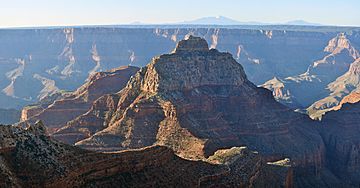Vishnu Temple (Grand Canyon) facts for kids
Quick facts for kids Vishnu Temple |
|
|---|---|

North aspect, from Angels Window Overlook
|
|
| Highest point | |
| Elevation | 7,533 ft (2,296 m) |
| Prominence | 1,813 ft (553 m) |
| Isolation | 1.77 mi (2.85 km) |
| Parent peak | Wotans Throne (7,740 ft) |
| Geography | |
| Location | Grand Canyon Coconino County, Arizona, US |
| Parent range | Kaibab Plateau Colorado Plateau |
| Topo map | USGS Cape Royal |
| Type of rock | Coconino Sandstone |
| Climbing | |
| First ascent | 1945 |
| Easiest route | class 4 climbing |
Vishnu Temple is a tall mountain peak in the amazing Grand Canyon in Arizona, USA. It stands 7,533 feet (2,296 meters) high. This impressive peak is located in Coconino County.
It's about two miles south of the Cape Royal overlook on the Grand Canyon's North Rim. Vishnu Temple also towers about 4,900 feet (1,490 meters) above the Colorado River. An explorer named Frederick Samuel Dellenbaugh once said it was "without doubt the most stupendous mass of nature's carving in the known world."
What's in a Name?
Vishnu Temple gets its name from Vishnu, a very important Hindu god. He is known as the "redeemer of the universe."
In 1880, a person named Clarence Dutton gave the mountain this name. He thought the mountain looked like an "oriental pagoda," which is a type of temple building. Dutton started a tradition of naming Grand Canyon features after gods and goddesses from different myths.
The name "Vishnu Temple" was officially accepted in 1906 by the U.S. Board on Geographic Names.
First Climb to the Top
The very first time someone successfully climbed to the top of Vishnu Temple was on July 13, 1945. This amazing feat was accomplished by Merrel Clubb and his son.
How Vishnu Temple Was Formed
The top part of Vishnu Temple is made of a cream-colored rock called Coconino Sandstone. This sandstone forms steep cliffs. On top of the sandstone, there's a cap of Kaibab Limestone.
The Coconino Sandstone was formed about 265 million years ago. It was once sand dunes, just like the ones you might see in a desert today!
Below the Coconino Sandstone, you'll find other layers of rock:
- The Hermit Formation is below the sandstone.
- Below that is the Supai Group.
- Even further down are layers of Redwall Limestone, the Tonto Group, and finally the Unkar Group near the bottom of the canyon.
Rainwater that falls on Vishnu Temple flows south into the Colorado River. It travels through two creeks: Vishnu Creek on the west side and Unkar Creek on the east side.
Gallery













